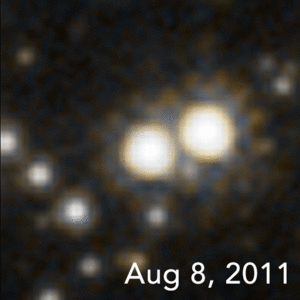Rogue black hole facts for kids

Imagine a black hole that isn't tied to any star or galaxy. It just floats freely through the vastness of space. This is what we call a rogue black hole. They are like cosmic wanderers.
Black holes are usually found orbiting stars or at the center of galaxies. But rogue black holes are different. They travel alone. Because black holes don't give off any light, finding these solo travelers is very tricky.
Scientists use special methods to spot them. One way is called gravitational lensing. This happens when a black hole's strong gravity bends the light from a distant star. It makes the star appear to wobble or brighten. Another way is by looking for X-ray bursts. These bursts happen when a black hole pulls in and destroys nearby objects.
Contents
Black Holes Between Galaxies
Some rogue black holes exist in the huge empty spaces between galaxies. These are called intergalactic rogue black holes. They don't belong to any specific group of stars or a galaxy.
How do they end up there? Sometimes, when two galaxies crash into each other, black holes can get kicked out. Also, if two black holes merge, the new, bigger black hole might get a powerful "kick." This kick can send it flying out into space.
Scientists think there might be about 12 huge rogue black holes. These giant black holes could be floating on the very edge of our own Milky Way galaxy. They are truly massive.
Black Holes Within Galaxies
Other rogue black holes travel inside galaxies. These are known as interstellar rogue black holes. They are still "rogue" because they don't orbit a star. They just drift through the galaxy.
A Real-Life Discovery
In January 2022, astronomers made an exciting discovery. They found a rogue black hole named OGLE-2011-BLG-0462/MOA-2011-BLG-191. This was the first time scientists clearly found and measured an isolated black hole. They used the powerful Hubble Space Telescope. They also used data from projects like Microlensing Observations in Astrophysics (MOA) and the Optical Gravitational Lensing Experiment (OGLE).
This black hole is about 5,000 light-years away from us. It is quite heavy, weighing about 7.1 times the mass of our Sun. It is also moving very fast, at about 45 kilometers per second. That's like traveling from New York to Los Angeles in just a few minutes!
While scientists had seen hints of other rogue black holes before, this one was special. It was the clearest and most direct proof. It helps us understand more about these mysterious objects.
Explore More About Space
- Rogue star
- Rogue planet
- Rogue extragalactic planets
- Rogue comet
- Tidally detached exomoon
- Stellar black hole
- Primordial black hole

